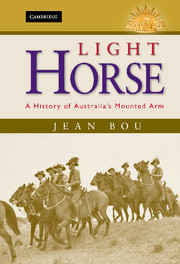Book contents
- Frontmatter
- CONTENTS
- List of maps
- ACKNOWLEDGEMENTS
- AUTHOR'S NOTE
- ABBREVIATIONS
- INTRODUCTION
- CHAPTER 1 ANCESTORS
- CHAPTER 2 TOUGH LESSONS
- CHAPTER 3 THE HUTTON ERA
- CHAPTER 4 UNFULFILLED PROMISE
- CHAPTER 5 THE LIGHT-HORSEMEN 1
- CHAPTER 6 MOUNTED RIFLES
- 7 CAVALRY
- CHAPTER 8 THE LIGHT-HORSEMEN 2
- CHAPTER 9 THE FINAL YEARS
- CONCLUSION
- EPILOGUE
- APPENDIX THE ‘BEERSHEBA CHARGE PHOTO’
- Notes
- BIBLIOGRAPHY
- INDEX
APPENDIX - THE ‘BEERSHEBA CHARGE PHOTO’
Published online by Cambridge University Press: 05 July 2014
- Frontmatter
- CONTENTS
- List of maps
- ACKNOWLEDGEMENTS
- AUTHOR'S NOTE
- ABBREVIATIONS
- INTRODUCTION
- CHAPTER 1 ANCESTORS
- CHAPTER 2 TOUGH LESSONS
- CHAPTER 3 THE HUTTON ERA
- CHAPTER 4 UNFULFILLED PROMISE
- CHAPTER 5 THE LIGHT-HORSEMEN 1
- CHAPTER 6 MOUNTED RIFLES
- 7 CAVALRY
- CHAPTER 8 THE LIGHT-HORSEMEN 2
- CHAPTER 9 THE FINAL YEARS
- CONCLUSION
- EPILOGUE
- APPENDIX THE ‘BEERSHEBA CHARGE PHOTO’
- Notes
- BIBLIOGRAPHY
- INDEX
Summary
The battle of Beersheba is perhaps the best-known light horse action of the Palestine campaign, having caught the public's attention more than any other single event of Australia's war in the Middle East. The attention stems, in large part, from a fascination with the remarkable charge by the 4th Light Horse Brigade, which captured the town of Beersheba and its wells at the end of a day-long fight on the last day of October 1917. This fascination is reflected in one of the enduring controversies surrounding the light horse, which relates to a photo held by the Australian War Memorial showing light-horsemen charging. The controversy arises because it has been claimed to be a photo of the 4th Light Horse Regiment taken during its charge on Beersheba, a claim that has been championed by the light horse historian Ian Jones, and to which he first gave new impetus in an article in 1983. His argument, made repeatedly and as one of the few detailed examinations of the photograph to have been made, met with a degree of acceptance through the 1980s and 1990s and has been repeated in serious history books several times; to such a point, indeed, that his claims have to some extent become established as part of light horse history. There are significant doubts about his claim, however, and whether it can be supported is hotly disputed. Since the photo first came to light in Australia some 90 years ago there has been a vigorous argument about what the photo actually depicts. Is it a picture of the charge, is it picture of a re-enactment of the charge, or is it something else altogether?
- Type
- Chapter
- Information
- Light HorseA History of Australia's Mounted Arm, pp. 264 - 279Publisher: Cambridge University PressPrint publication year: 2009

